Tomato hornworms (Manduca quinquemaculata) and tobacco hornworms (M. sexta) are large, blue-green caterpillars (larvae) with a spine (horn) on the posterior (rear) end. These insects do not typically cause significant damage in commercial vegetable fields. However, large numbers of larvae can occasionally occur in home gardens, leading to significant damage. Tomato and tobacco hornworms feed only on solanaceous plants (i.e., plants in the nightshade family), most typically tomato and less commonly eggplant, pepper and potato. These insects can also feed on solanaceous weeds such as horsenettle, jimsonweed and nightshade.
Appearance: You can easily identify hornworms by their blue-green color and large size. When fully grown, hornworm caterpillars (larvae) can be up to four inches in length and easily seen. However, smaller hornworm larvae, due to their color, tend to blend in with plant leaves and can be difficult to detect. Tobacco hornworms and tomato hornworms have seven or eight diagonal white stripes, respectively, on each side of their bodies. A large red or black horn-like spine protrudes from the posterior (rear) end of caterpillars, giving rise to the name “hornworm”. Adult hornworms are large, heavy-bodied hawkmoths with a wingspan of up to five inches. Adults are often mistaken for hummingbirds due to their large size, rapid wingbeats and quick movements.
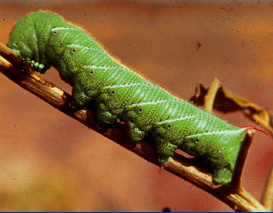
Symptoms and Effects: Hornworm larvae primarily feed on tomato leaves but occasionally feed on green fruit. Hornworm larvae can devour up to four times their weight in leaves and fruit each day. If left unchecked, they can defoliate a tomato plant. In addition, hornworm-damaged fruit often decay on the vine before harvest, or they may not rot but end up with dry feeding scars that make them unusable.
Adult hornworms/hawkmoths feed on nectar and do not harm plants.
Life Cycle: Tomato hornworms overwinter as pupae in the soil. Adults emerge in late June and lay pale-green, spherical eggs on the undersurface of tomato leaves. Once eggs hatch, larvae immediately begin feeding, and they feed continually for approximately one month. Larvae eventually drop from plants to pupate (i.e., transform from larvae into moths). In the upper Midwest, up to two generations of hornworms can occur per year.
Control: Hornworms rarely cause enough damage to warrant the use of insecticides in home gardens and smaller commercial plantings. In these settings, frequently monitor tomatoes for hornworm larvae from early July through August, and hand pick the larvae from plants as needed. Till the soil after harvest to destroy any burrowing larvae that are attempting to pupate. Tillage can kill up to 90% of larvae in the soil.

Natural control of hornworms can also occur. Insects such as lady beetles, green lacewings and some predatory wasps eat hornworm eggs and smaller larvae. Another wasp (called the Trichogammid wasp) kills hornworms by parasitizing their eggs. Yet another wasp (called the Brachonid wasp) lays its eggs on larger hornworm caterpillars. The larvae of this wasp feed inside the caterpillars and kill them. If you see parasitized hornworms on your tomatoes, DO NOT remove them. They will produce more wasps that can lay eggs on and kill other hornworms.
If you are a tomato grower with a large acreage of tomatoes, monitor your tomatoes and treat with insecticides if you find an average of more than two hornworms per plant. Hornworm infestations are often localized and spot treatments will usually take care of any problem. Apply products for hornworm control when larvae are small; larger larvae are more difficult to control. There are several insecticides available to control hornworms. Refer to the University of Wisconsin-Extension publication Commercial Vegetable Production in Wisconsin (A3422) for a full list of insecticides and recommendations.
For more information on hornworms: See UW-Extension Bulletin A3422, or contact your county Extension agent.
Download Article





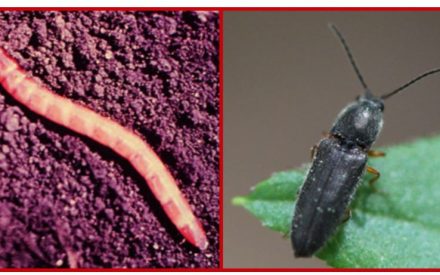 Wireworms
Wireworms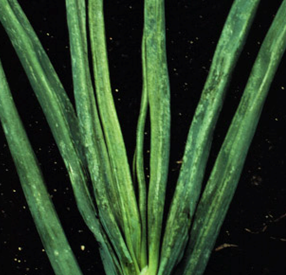 Onion Thrips
Onion Thrips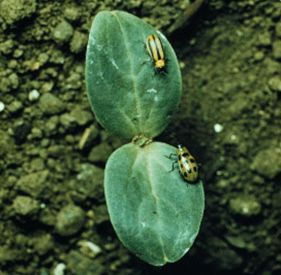 Cucumber Beetles
Cucumber Beetles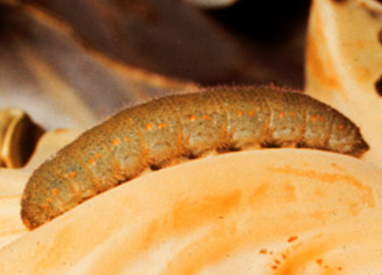 Imported Cabbageworm
Imported Cabbageworm


